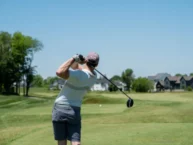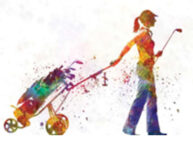I don’t know about you, but once in a great while I’ve run into a golfer who has no clue about golf etiquette or how to behave on a golf course. Usually this is a new golfer with little “on-course” experience and I’m willing to let a few things slide. And, in my experience, when you tell a new golfer about his or her social gaff, they are grateful to learn and appreciative of the information.
But when an experienced golfer is just plain rude, noisy or out of control, it’s really annoying and ruins the golfing experience for everyone. There’s no excuse for bad behavior on the golf course. If you are serious about playing golf there are a few essential points of etiquette you should know and practice.
Tee Times
If you schedule a tee time on a course (public or private) be sure to keep your tee time and in fact, be sure to show up early. Not only should you use the time to warm up but it allows the starter to know you have arrived. And don’t be surprised if the starter is eager to send you out early. At my club, the starter is always happy to get teams out and playing as close to their scheduled tee times, earlier if possible. The club does not want to leave a tee time unfilled. If you or your group are late, you might not be able to get out at all.
Be smart about scheduling tee times. Don’t sign up for a tee time that follows a league. Men or women—doesn’t matter, groups of golfers always take more time to play. If you’re a long hitter and you don’t want to wait behind a group you know will be playing slowly, schedule a tee time on another day, first thing in the morning, or later in the day.
Be patient. Golf is supposed to be fun. If you find yourself playing behind a slow group, wait until they have finished the hole and then ask if you can play through. If they refuse or simply don’t acknowledge your request, you’re stuck, but most golfers are aware of the situation and they will let you play through. No one likes having someone breathing down their necks while they play.
On the other hand, be aware that if the group in front of you is playing slow, the cause might very well be the slow play of the group in front of them. Golf courses can get pretty crowded, especially on weekends. At times like these you must resign yourself to the pace of play and learn to relax. If there is a course ranger available, you can always ask his advice. If there is an empty hole up ahead, a ranger can sometimes recommend you skip over to it, play it and then return. As long as it does not interfere with other golfers on the course, this can be a solution. This happened to me once when I was playing in Florida. The ranger had our group jump ahead to play the open hole, then come back around and play the hole we had been waiting on.
Mark your ball with a personal symbol (dots, initials, etc.) and let your fellow players know the type of ball you are playing. This avoids confusion and possible penalties if you happen to hit the wrong ball, or lose one in the woods.
Don’t stand too close behind or in front of another player when they are hitting. You don’t want to be a distraction in any way. Don’t be afraid to ask another player to step out of your line of site or peripheral vision if they are distracting you.
Be absolutely quiet while another player hits. It’s bad etiquette to talk, whisper or start rattling through your golf bag while another golfer is making his or her shot. Even pulling off the velcro on your golf glove can prove to be annoying. Wait to remove the glove until after the other player has hit. And if you are the driver of a golf cart, stop and wait until the play is complete. This also applies to golfers nearby. If you are driving your cart within close proximity of players on the next tee box or green, it’s good practice to stop and wait until they finish rather than barrel on through.
Play ready golf. Unless you are in a tournament, ready golf is the way to keep play moving along smoothly. As you walk up to your next shot, take advantage of the time to assess the situation, and think about your next club choice. The player furthest from the hole is next to play, but be ready to play when it is your turn.
Look out for each player’s golf ball. When a player in your group hits, pay attention to where the ball lands, especially if it ends up in the woods or rough. This can be very helpful if a ball is way off target. Be willing to assist in finding a lost ball.
Repair any damage to the course. Replace divots on the golf course, repair ball marks on the green and rake the sand in a bunker to remove your ball marks and footprints.
Cart Etiquette. Don’t drive your golf cart or pull your hand cart over greens, tee boxes or sand bunkers. Stay on the cart path on par 3s and follow the cart signs set up by the maintenance crew to avoid damaging the fairways.
Always leave your golf cart on the side of the green nearest the next tee box. This keeps play moving more smoothly. There is nothing more annoying than having to wait to play while you watch golfers ahead of you on the course, criss-cross the fairway picking up clubs and grabbing pull carts when they could have left their clubs near the next tee.
On the green. Once everyone is on the green, the flagstaff should be removed from the hole and placed out of the way. If you have another club (i.e. wedge) with you, place it across the flagstaff. This makes it easy to find and avoids leaving a club behind.
On the green, the player furthest from the hole plays first. Be careful not to step on anyone’s target line. Mark your ball if it interferes with another player’s lie or could possibly be hit by another player’s ball. Watch that your shadow does not interfere with another player’s line or is distracting. If it is not possible to stand without your shadow crossing a player’s line, then stand very still. Be like a tree!
Avoid any damage to the green or the hole, especially when replacing the flagstick. Too many times one of my putts has gone astray because of a nipped cup lip that had been damaged when a flagstick hit the edge when it was placed back into the hole.
Never mark your score card on the green. Wait until you get to the next tee to mark your card. That way the players behind you can play up and keep the game moving.
When you play at an unfamiliar course…
Call ahead to check if there are any special local rules re: attire, use of carts, etc. and to be sure there are no local tournaments happening on the day you intend to play.
Pay your green fees in advance, and be sure to get to the course ahead of your tee time, and ask in the pro shop if there are any special circumstances on the course that day. (i.e. maintenance, ground under repair, etc.)
. . . . .
One point of etiquette is being prepared to repair your own divots and ball marks on the green. You might find these short videos helpful.
. . . . .
. . . . .
. . . . .
What’s your best strategy when play is slow on the golf course? Do you ask to play through, or just grin and bear it?





Pat,
I hope all those who receive your Golf Gurls email REALLY take the time to read your great advice/tips on golf course etiquette. If we all apply (and remember) the advice, it will make our rounds of golf more enjoyable.
Good Job!